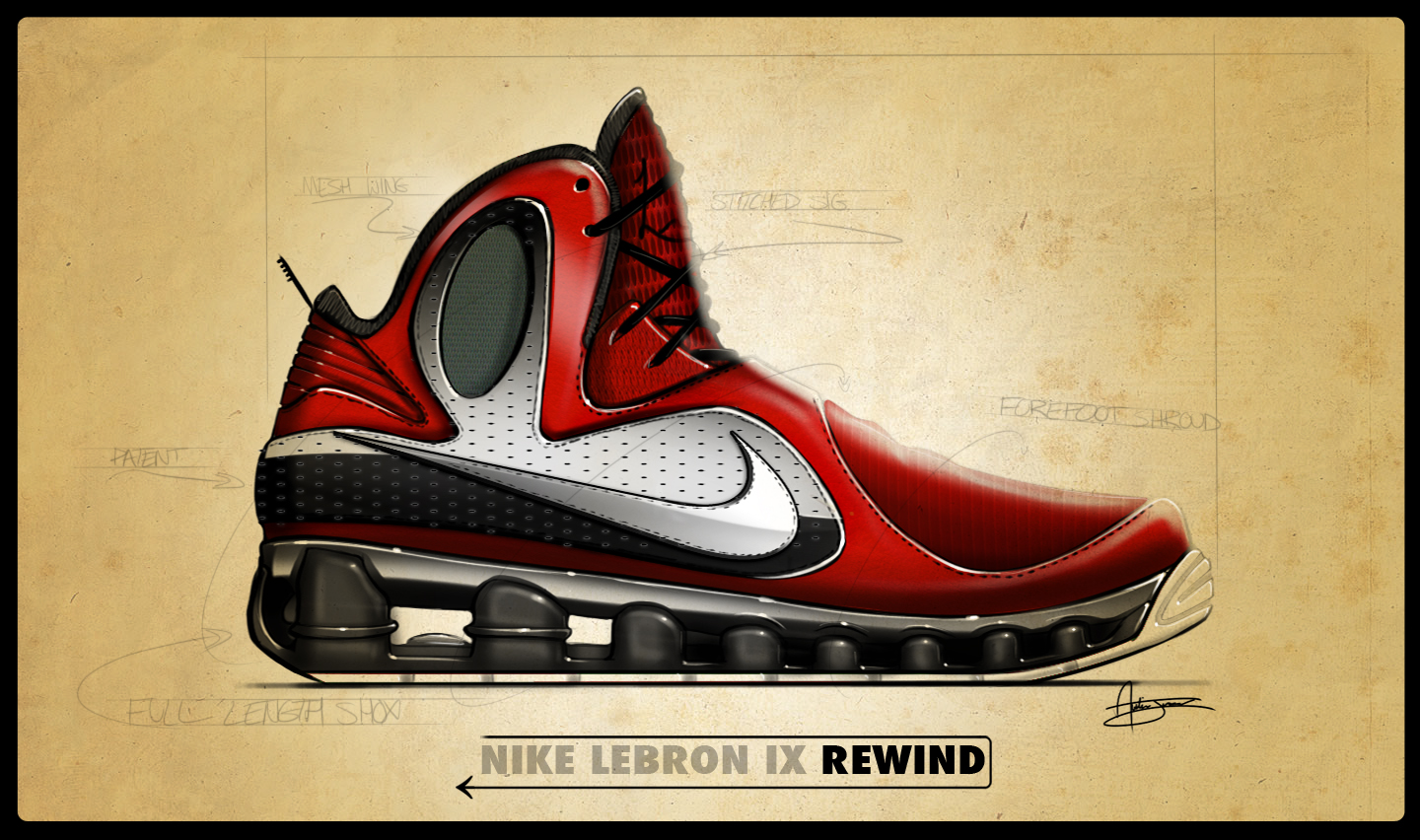
words & images // Austin Jermacans
4Cent Friday is a weekly design blog on SoleCollector.com written by a member of the 4Cent Design team. Subjects may range from discussing rendering skills to design inspirations, to thoughts and opinions on the state of footwear design as a whole. For more background on 4Cent Design, check our interview here.
At a time where footwear is evolving at a faster rate than ever, perhaps it goes unnoticed at times just how outdated technologies, materials and designs in general have easily become. As a designer, it’s critical to notice these changes because you need to adjust to these trends. The more your work begins to mirror designs that would have released last year rather than next year, the more likely you will be finding yourself without a job.
Looking only ten years back at Nike Basketball footwear, there were quite a few initiatives that the category was clearly getting after. We saw the introduction of SHOX technology, the use of interchangeable MORF uppers and the first signs of attempted lightweight footwear. If you were to compare those once-cutting edge technologies to today’s standards, you can realize just how fast of a pace our performance footwear is evolving. Today, SHOX is nearly irrelevant, appearing only in Nike Running models and in an enhanced Max version for hoops. MORF is non existant entirely, lasting just one season, and the lightweight models of the early 2000’s are just average when compared to the feather weight models of today, like the adidas Crazy Light and Nike's Hyperdunk. Due to the current emphasis on weight -- a lack of it, at least -- in the shoe market, materials have evolved as well to help shave every last ounce away. Fuse and Flywire applications have made synthetic uppers the key to achieving a lighter sneaker, and leather is only used sparingly.

Recently Nike has taken an interesting approach to their back catalog and has began to release older models with newer technologies applied to keep them relevant by today’s standards. Examples that recently released would include the Jordan 2.0, featuring a full Air Max 360 bag, and of course, the numerous Air Max runners with Fuse uppers. It definitely creates a new and interesting design language for the classics of yesterday.
While I'm busy designing for work daily, I often find myself setting some time aside to work on other small projects or ideas I happen to think of. For one, it helps inspire current and future work, and two, well, it’s always good to get away from something you’ve spent all day working on. I like to think of it like recess.

For this week’s writeup, I spent some free time I had over the past few days to take a different approach to Nike’s reissued sneakers, and do the exact opposite. I designed three of Nike’s elite models of today, the Lebron 9, Kobe VI, and Hyperdunk 2011, as if they were released in the early 2000’s. I thought it would help show the interesting contrast between the two eras and the huge differences in technologies, materials and design -- despite only being 10 years apart.
I started with the Kobe VI. When I looked back at the sneakers in the early 2000’s, I tried to pinpoint the technologies best suited to create a conversion. I thought, "If Nike were to have a snake skin styled upper, what would be their solution?" My initial idea was to create a debossed Foamposite upper, hinting to Kobe’s Flightposite PE’s, but I wanted to go lighter. Introducing a MORF upper would probably be my best solution, as it opened up a wide variety of ways to incorporate the snake design while keeping the design minimalistic, as the VI is. MORF, a modular shoe technology that featured interchangeable skins and outsoles, was seen in the signature lines of Jason Kidd, Gary Payton and Scottie Pippen.
I felt the MORF styling actually allowed the Kobe VI to appear more holistic, as the snake print stretches across the whole upper, with only the zipper interfering. The only additional piece on the upper is the swooping leather toe rand, to help add support where needed. The MORF design also comes in handy because despite the low height of the collar, additional support could be provided through a Monkey Paw, an anti-inversion TPU support piece used often during the 2000 era. Lastly, the Swoosh graphic was inspired by the Nike Zoom Kidd (seen at the bottom left of the very top image), which featured an entirely digital design sans toe cap.

Next was the new LeBron 9. Taking a slightly different approach than with the Kobe VI above, I tried to picture what Nike would have LeBron wear if he played in the NBA a decade earlier. Being the high flying athlete that he is, I saw him fitting in well with the SHOX ads right alongside Vince Carter. It could have been the fact he wore several SHOX PEs while at SVSM, but I think full-length SHOX could've been really pushed for LeBron due to his size and strature. It probably could have worked out really well for them, and maybe even extended the lifespan of the almost dormant technology.
The aggressive nature of LeBron James complements the aggressive teeth-like appearance of SHOX, and what I love about the Lebron IX is the abstract shape that stretches across the sneaker. It really has a classic and flowing mid 90’s feel to it, which actually inspired this writeup. I wanted to keep the emphasis on the heel design element, so I kept the rest of the upper minimalistic. I took inspiration from the VC 1, and included a forefoot shroud to cover some of the lacing. Perfs and a cutout wing were added for ventilation and to fully provide that 2000’s feel.

The Hyperdunk immediately reminded me of the Hyperflight, due to its sleek silhouette and light weight, so I figured the Hyperdunk 2001 would have been something perhaps similar to the Hyperflight. The patent leather upper immediately pays homage to the Hyperflight, and I wanted to evolve more on the design cues from the Hyperdunk 2011. The triangular TPU pattern featured on the HD11 was expressed in the debossed upper through perfs, allowing air flow through both medial and lateral sides.
One of the most noticeable elements of the Hyperdunk series has been its highly scupted external heel counter, and I altered the TPU heel here to be a bit more aggressive like the Hyperflight, and also allow for some material insets. The lenticular heel was inspired by the early full lenticular upper weartest samples made by Nike, which were definitely crazy. Other than that, the rest of the design is pretty obvious. An all leather upper Hyperdunk is something that I think could be realistically done for today and still be relevant. As Nike releases several different models of each signature shoe for its players, a summer version made to hold up for outdoor play could serve well for the Hyperdunk.

Well, what do you think of the concept and approach? Obviously there's been quite a consumer response to the re-introduction of many classics from Nike that have been updated with today's technology and construction, but would you want to see the reverse happen?
Let us know if there are any particular models from today's market that you'd like to see styled after great eras like the late 80's or mid 90's. Maybe you'd even like to see the three shoes that inspired the above sketches, the Zoom Kidd, Shox VC II and Hyperflight, all updated to today's design language and materials?

